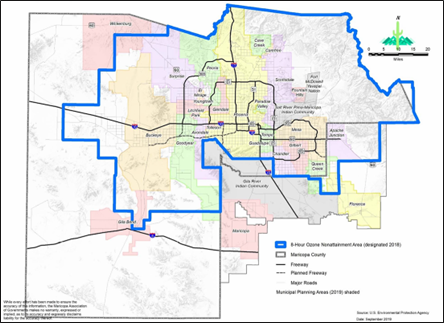Updated NSR Requirements for the Phoenix-Mesa Ozone NAA
The Phoenix-Mesa ozone nonattainment area (NAA) failed to attain the 2015 8-hour ozone National Ambient Air Quality Standards (NAAQS) by the August 3, 2024 deadline set by the Environmental Protection Agency (EPA) in 2022. The Arizona Department of Environmental Quality (ADEQ) is preparing for the possibility that the Phoenix-Mesa NAA will be redesignated to serious nonattainment “within the next year”.

Arizona currently has two ozone nonattainment (NA) areas. The Phoenix-Mesa ozone NA area (NAA) is in moderate NA for the 2015 ozone NAAQS and consists of the northeastern half of Maricopa County, a small middle-northern section of Pinal County, and a middle-western sliver of Gila County. The Yuma ozone NAA is in Marginal NA for the 2015 ozone NAAQS and consists of the small area directly surrounding Yuma, AZ. Since only the two lowest tiers of ozone NAA are currently present in Arizona, the State Implementation Plan (SIP) does not incorporate certain sections of the Clean Air Act (CAA) that regulate severe ozone NAAs.
CAA sections 182(a) and 182(b) regulate marginal and moderate ozone NAAs respectively and are already completely implemented in the Arizona SIP. CAA section 182(c) describes the SIP revisions required for serious ozone NAAs. Section 182(c) is only partially implemented in the SIP, with section 182(c)(6) currently absent. Therefore, ADEQ is proposing to adopt CAA section 182(c)(6) into a revised SIP for the Phoenix-Mesa NAA by the end of 2025, before the area’s potential redesignation to serious ozone NA.
Why is this important? CAA Section 182(c)(6), “De minimis rule”, governs how emissions increases at major sources are determined to be major modifications. Major modifications are subject to NA new source reviews (NNSR), a considerable permitting burden, in ozone NAAs. In marginal and moderate ozone NAAs, a project’s emissions are first compared against “significant thresholds”, 40 tons per year (tpy) of volatile organic compounds (VOC) and 40 tpy of nitrogen oxides (NOx) in moderate ozone NAAs. If the project emissions are lower than these thresholds, the project is not considered a major modification and is therefore not subject to NNSR. If a project’s emissions are greater than one or more of these “significant thresholds”, the major source must sum all the emissions increases and decreases from projects over the past five years with the emissions from the proposed project to find the net emissions increase. If the net emissions increase is greater than one or more of the “significant thresholds”, then NNSR applies to the project. In essence, a project at a major source is only subject to NNSR if it both exceeds a “significant threshold” on its own AND when netted with projects over the past five years.
In severe nonattainment zones, CAA section 182(c)(6) changes how NNSR applicability is determined. Under CAA section 182(c)(6), NNSR applicability is determined based on the net emissions increase alone. This means that if the net emissions increase over the previous five years at a major source in a serious ozone NAA exceed either the VOC or NOx “significant thresholds”, NNSR will apply to the proposed project, even if the project emissions alone do not exceed the thresholds. Additionally, the VOC and NOx “significant thresholds” under serious ozone NA are lower than those in moderate ozone NA, with both VOC and NOx set at 25 tpy.
There are some caveats. First, it is important to note that redesignation of the Phoenix-Mesa area to serious ozone NA area is still undecided. ADEQ is preemptively revising the SIP to ensure full compliance with CAA section 182(c). Second, the comment period for the proposed changes recently ended on October 7, 2025, meaning ADEQ may revise the proposed changes.
With these caveats in mind, what are some prudent practices environmental, health, and safety (EHS) managers can implement to stay ahead of serious ozone NA redesignation?
First, identify if your facility is considered a major source based on VOC or NOx emissions. Facilities with significant solvent or coating usage, large burners/engines, or large banks of diesel generators can emit large amounts of VOC or NOx. The major source thresholds for VOC and NOx are listed in the table below.

